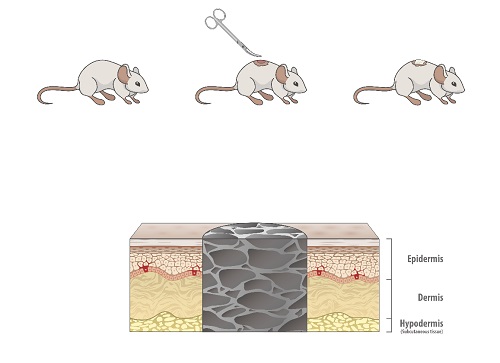Qin Yan's group and University of Science and Technology Beijing make important progress in improving the performance of wound dressings
On March 12, 2019, Biomaterials published the results of a collaborative study between the research team of Qin Yan and Professor Wen Yongqiang of the University of Science and Technology of Beijing, entitled "Layered Nanofiber Sponge with an Improved Capacity for Promoting Blood Coagulation and Wound Healing". This work changed the traditional structure of wound dressing and had an important impact on hemostasis and tissue reconstruction. The layered nanofiber structure could effectively accelerate wound healing and reduce scar formation.
Effective bleeding control and wound healing are very important and can be life saving. However, traditional wound dressings with structural deficiencies are not effective in controlling bleeding and promoting the regeneration of functional tissues. In this study, a three-dimensional (3D) layered nanofiber sponge was obtained by expanding two-dimensional (2D) nanofiber membranes into the third dimension. This sponge has a layered nanofiber structure, which increases the interfacial interaction between the sponge and blood cells to accelerate hemostasis. Through fine-tuning of structure, the 3D nanofiber sponge acquires properties beneficial to wound healing such as good elasticity and high permeability and fluid absorption ratio. The 3D nanofiber sponges are both highly compressible and resilient, providing tamponade for deep wounds and creating a good 3D dynamic micro environment to regulate cellular behavior. Further research has demonstrated that the layered nanofiber structure could promote the regeneration of functional dermis and the restoration of differentiated adipocytes during the early repair phase. Experiments using model mice with full-thickness skin defects have shown that the layered nanofiber structure could effectively accelerate wound healing and reduce scar formation. This layered 3D nanofiber sponge design is easy to produce. Due to its excellent wound healing property, this porous nanofiber sponge has great potential for future clinical application as wound dressings.
This study was funded by the followings: the National Key R&D Program of China, National Natural Science Foundation of China, Strategic Priority Research Programs (Category A) of the CAS, Key Research Program of Frontier Sciences, CAS and Beijing Natural Science Foundation.

Schematic showingthe tamponade effect of the 3D CS/PVA nanofiber sponge in the full-thickness skin defect mouse model.
(Imaged by Dr. Qin Yan's group)
Article link: https://doi.org/10.1016/j.biomaterials.2019.03.008
Contact: Qin Yan, Ph.D.
Associate Professor
Institute of biophysics, Chinese Academy of Sciences
Beijing100101, China
Tel: (86)-10-64888434
Email: qiny@ibp.ac.cn
(Reported by Dr. Qin Yan's group)

